 This weekend I am so fortunate to be in Munich keynoting the ECIS Technology Conference. It’s such a pleasure to be back in the city that was our first international home, and an honor to be keynoting the very first educational technology conference I ever attended all the way back in 2002!
This weekend I am so fortunate to be in Munich keynoting the ECIS Technology Conference. It’s such a pleasure to be back in the city that was our first international home, and an honor to be keynoting the very first educational technology conference I ever attended all the way back in 2002!
The theme of the conference this year is “building engagement” so I decided to build my presentation around the theme of “learning with technology the way we live with technology” – a phrase my former colleague, Justin Medved & I used to say all the time when we worked together at ISB. The quote has always stuck with me, but I’ve never used it as a throughline for a presentation before, and I felt this was a perfect fit!
I promised to share my resources for the session (and just intended for this post to be just a list of supporting links, but I got a bit carried away, so now it’s more of a descriptive summary of the presentation with links embedded).
Intro
If you prefer more of a short version, here’s the blurb for my session:
Making the Connection
We’ve all had the experience of settling an argument in a restaurant with a quick Wikipedia search, or navigating around a new city with Google Maps, but all too often our use of technology in the classroom is disconnected from these types of real-world uses. However, when we learn with technology the way we live with technology, the classroom can be just as relevant and engaging as our everyday digital interactions. How can we make the connection between our real-life experiences and our classroom learning environment so that we can better prepare our students to excel in this dynamic and interconnected world?
From my view on stage, it seemed like the audience was really getting into the conversations:
Huge thanks to Mark and Sonya for creating beautiful visual notes (that are definitely the best summary) of the session!
Presentation
If you prefer to see the whole thing, here is my presentation:
Summary & Resources
And for those that want the really long version, including all of the resources from the presentation above, here’s what has turned out to be basically a summary of what I said this morning: As I was developing the ideas for the presentation, I thought about all of the different ways that I use technology in my daily life (building off my L2Talk from Learning2 at NIST last October) and how we can apply that kind of learning in the classroom. Thinking about my learning over the past few months, there were a few key themes that really stood out to me:
Mobile
Being able to use my device (usually my phone) when I’m “out on the town”, particularly in Tokyo (or other big cities in Japan), is absolutely essential for navigation. In fact, I’m not quite sure how I would have survived in Japan without Google Maps! Which makes me wonder, why do we teach students about the world around us with paper maps and an atlas, when we can get out there and explore the world around us – just the way we do when we’re trying to navigate a new city.
At YIS, we’ve done this in lots of different ways, from our grade 7 students using their iPads as they move around the classroom and school, to taking them out on fieldtrips as they explore Yokohama, to taking advantage to all of the different ways to explore our world with Google Maps.
Customizable
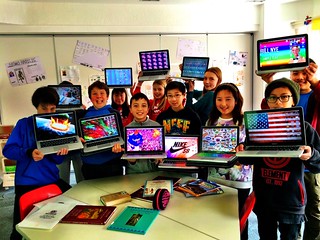 One of the things I love about technology is the ability to customize each device exactly how I want it. I know when I get a new phone, the first thing I do is set up all my apps exactly the way I want them, get a new case, and generally just make it mine. Our students love to do exactly the same thing (check out this beautiful color coded home screen).
One of the things I love about technology is the ability to customize each device exactly how I want it. I know when I get a new phone, the first thing I do is set up all my apps exactly the way I want them, get a new case, and generally just make it mine. Our students love to do exactly the same thing (check out this beautiful color coded home screen).
However, I’ve seen so many schools expect students (and teachers) to be productive on devices that they are not the administrator of, devices where they have limited abilities to do even basic things on their laptops – from downloading software, to changing the desktop.
One of the things I’m most proud of in the development of our Connected Learning Community at YIS, is that the students are responsible for making good decisions. This means they are empowered, as the administrators of their devices, to customize them exactly as they want, to make choices about how they use their devices, and to learn from their mistakes. Our Digital Dragons digital citizenship curriculum, along with our Digital Citizenship Week, helps them build their understanding of safe, responsible and ethical behavior online, they have tons of opportunities to share what they’ve learned with their parents, and when/if they make mistakes, we have an effective (and very YIS) process for helping them learn how to make better choices.
Social
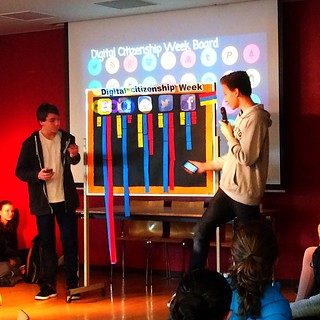 Pretty much all of my learning takes place in social spaces – from following individuals and groups on Facebook & Twitter, to discovering new content and resources through Zite & Flipboard, and sharing & watching on Instagram – my learning takes place with others. And the best part is that those online connections very often turn in to real world connections – the Learning2 conference being one of my favorite places to catch up with my Personal Learning Network every year, but even here, all the way in Europe, I’m so excited to see so many familiar faces (lots of whom used to be teaching in Asia too).
Pretty much all of my learning takes place in social spaces – from following individuals and groups on Facebook & Twitter, to discovering new content and resources through Zite & Flipboard, and sharing & watching on Instagram – my learning takes place with others. And the best part is that those online connections very often turn in to real world connections – the Learning2 conference being one of my favorite places to catch up with my Personal Learning Network every year, but even here, all the way in Europe, I’m so excited to see so many familiar faces (lots of whom used to be teaching in Asia too).
Of course our students are also well connected in social spaces – this year when we tracked the networking sites our students use the most (during Digital Citizenship Week), the top social app was Snapchat (last year it was Instagram, the year before Tumblr). If these are spaces that we find valuable learning opportunities, and we know that students are using them already, can we find opportunities to use them in our classrooms too?
At YIS, we are very fortunate to have a really strong school community – we are friendly and welcoming in a face to face environment, and we are also great about sharing in online spaces. A few examples are the #yisreadseverywhere hashtag to promote reading, inspired by our awesome Head of English, Cari Barbour; our IB Chemistry Google+ group facilitated by science superstar (and COETAIL graduate) Merilyn Winslade; our YIS Arts Facebook group created by former YIS teacher, Frank Curkovic, of course our public student (and teacher) blogs.
Media Rich
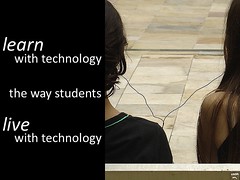 One of the things I’ve noticed recently, in particular, as I’m exploring more about strength training and lifting heavy things, is that the more interactive and media rich a resource is, the more valuable it is to me. Being able to watch someone perform a lift properly (and to film myself and share with my friend and coach, Heather), or listen to someone explain something (on a podcast) as I’m giving it a try, or to download apps that let me do all of that in the same place and track my progress, has been invaluable.
One of the things I’ve noticed recently, in particular, as I’m exploring more about strength training and lifting heavy things, is that the more interactive and media rich a resource is, the more valuable it is to me. Being able to watch someone perform a lift properly (and to film myself and share with my friend and coach, Heather), or listen to someone explain something (on a podcast) as I’m giving it a try, or to download apps that let me do all of that in the same place and track my progress, has been invaluable.
We know students are also readily engaged by media rich experiences – I see it in my husband, Alex Guenther’s, classroom every day when he teaches just about anything and everything through a series of YouTube videos (interspersed with his own stories and other resources).
So, why are we often asking students to produce two dimensional paper products (posters, reports, magazines, whatever the case may be), when we can encourage them to create multimedia and interactive demonstrations of their understanding?
A few examples from YIS are the YIS Tutorials wiki – five years of awesome student-created tutorials curated in one place, student produced podcasts in grade 6 English in Madeleine Cox’s class (another COETAIL graduate), or all of the awesome projects are grade 7 students are creating as part of the 2:1 program.
Motivating
A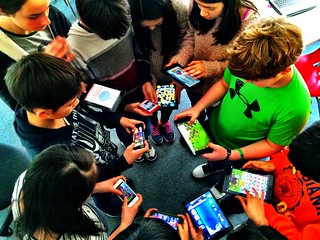 bout two years ago a FitBit craze swept YIS (well, it swept through about 10 of us), ever since then I’ve been fascinated by the way such a tiny device can be so motivating. I never used to be all that interested in badges (my girl scout sash was not very impressive in middle school), but there’s something about the ease with which the device tracks my steps, keeps me updated about how I’m doing and if I’m meeting my goals, and allows me to challenge myself, that is surprisingly motivating.
bout two years ago a FitBit craze swept YIS (well, it swept through about 10 of us), ever since then I’ve been fascinated by the way such a tiny device can be so motivating. I never used to be all that interested in badges (my girl scout sash was not very impressive in middle school), but there’s something about the ease with which the device tracks my steps, keeps me updated about how I’m doing and if I’m meeting my goals, and allows me to challenge myself, that is surprisingly motivating.
When I asked students about some of their favorite games last week, they highlighted many of the same kinds of features as motivating for them too: the ability to challenge themselves, immediate feedback and tracking of how they do, the opportunity to play against others, and the interactivity.
So, instead of asking students to demonstrate their understanding in traditional formats (like presentations and reports), could we instead immerse them in a virtual world that motivates them to keep learning, allows them to connect with others, and to actually “be” a part of the content they’re learning about.
At YIS, like many schools, we use Minecraft a ton, particularly in Humanities classes where they do things like build the silk road while they learn about the history, create structures in specific biomes, build famous structures from ancient civilizations and walk among them, or learn about the value of community in a virtual space.
Just in Time
We’ve all experienced the gratification of being able to solve an urgent and complicated question (like “what are corn nuts?”) in a bar – having the tool that you need at just the right time is what mobile learning is all about. Instead of asking students to memorize content just in case they might need it in the future, could we apply a more “just in time” approach, and allow students to engage with the content within the context of their course learning?
At YIS, Rebekah Madrid (another COETAIL graduate) has done a fabulous job of bringing content to life through the use of Twitter – where students are both learning the content, sharing their learning, and reflecting on their learning all at the same time – just like we do at conferences. One of my favorite examples of this is her Tweeting the Civil War project from grade 9 history, but she’s still going strong with her Live Tweeting a History Class!
Wrapping it all up
A few weeks ago, I came across this post, by George Couros, about Snapchat. Now, I have to admit that I had not downloaded Snapchat (or even considered downloading it) until I watched the video in his post:
To me, there are lots of elements in this video that highlight many of the above features of what I find valuable in my use of devices for learning – and it certainly shares what the younger generation finds useful and valuable. In my mind, finding ways to tap into the usefulness and practicality of these kinds of interactions in our classroom environment takes us to the redefinition level of SAMR in a really authentic and engaging way.
Share Your Ideas!
If you decide to try out any of these ideas, or you have other resources to share that fit within these themes, please share in the comments below!
I’m pretty sure my session was recorded, so when the video is available I’ll share it here too!
Images
- Great energy in the room as ECIS Tech 2015 starts by superkimbo
- Engaging Learners by superkimbo
- Gr6 shows of their custom desktops by superkimbo
- Gr7 and their Favorite iOS games by superkimbo
- Learn the way we live by superkimbo
- Wrapping Up Digital Citizenship Week at YIS! by superkimbo






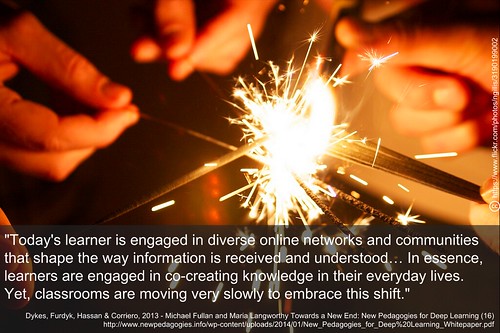
Kim–I received this posting in my email this morning and I wasn’t going to open it as I hadn’t remembered subscribing to “always learning.” Am I happy that I did. I am re-energized and excited about so many possibilities, and came away also feeling rather inadequate! I’ve shared your posting with my elementary and upper school teachers to see how they respond. Teaching in an international school where the technology is spotty presents challenges, but the vision and goals are universal. Thank you. YIS is fortunate!
Kathy Fester´s last blog post ..Try Awesome Stories!